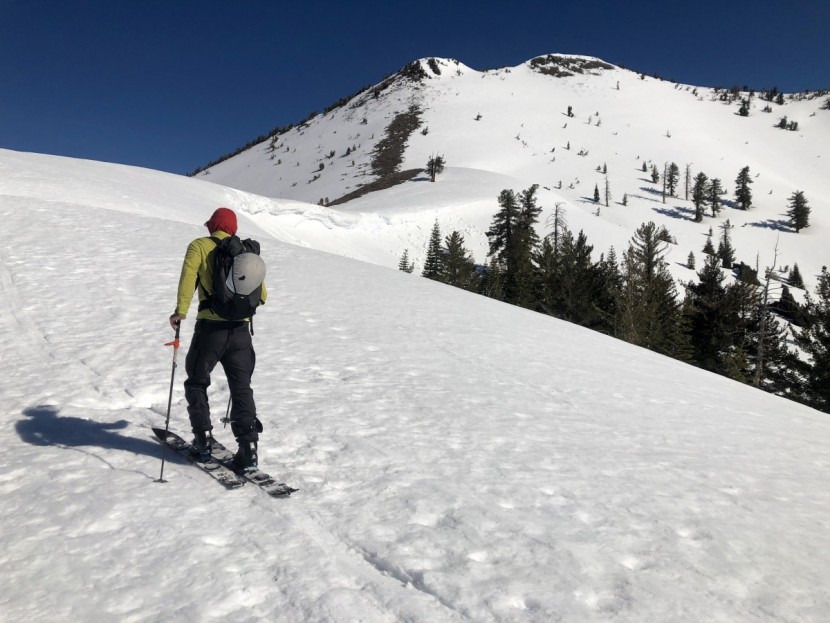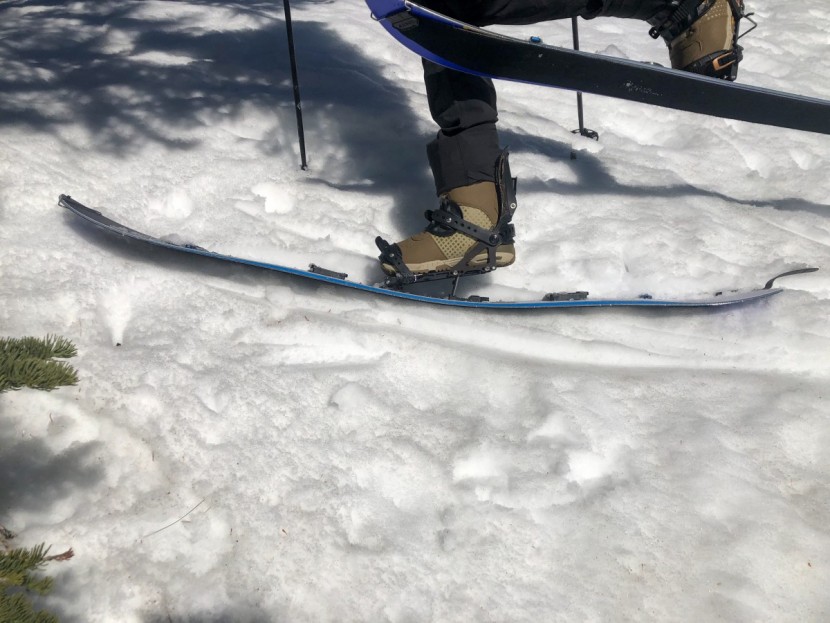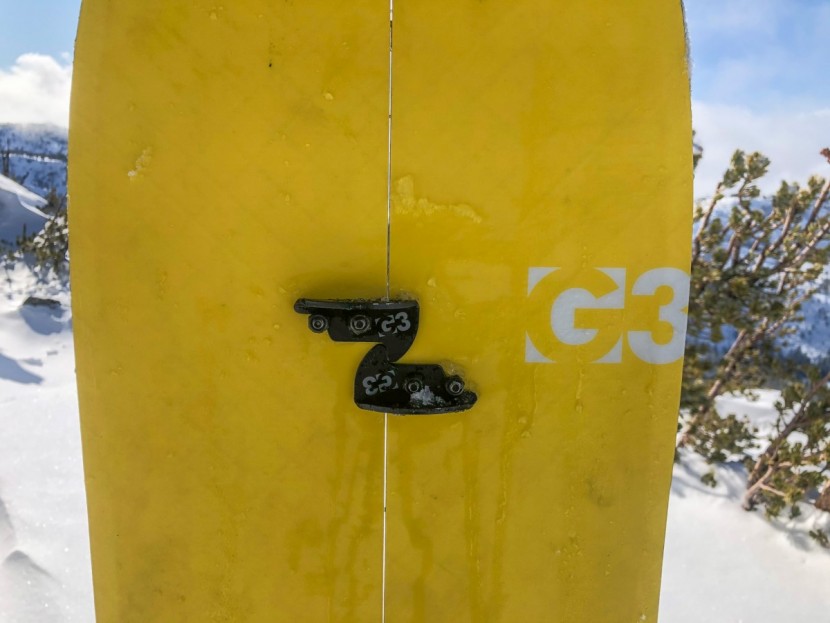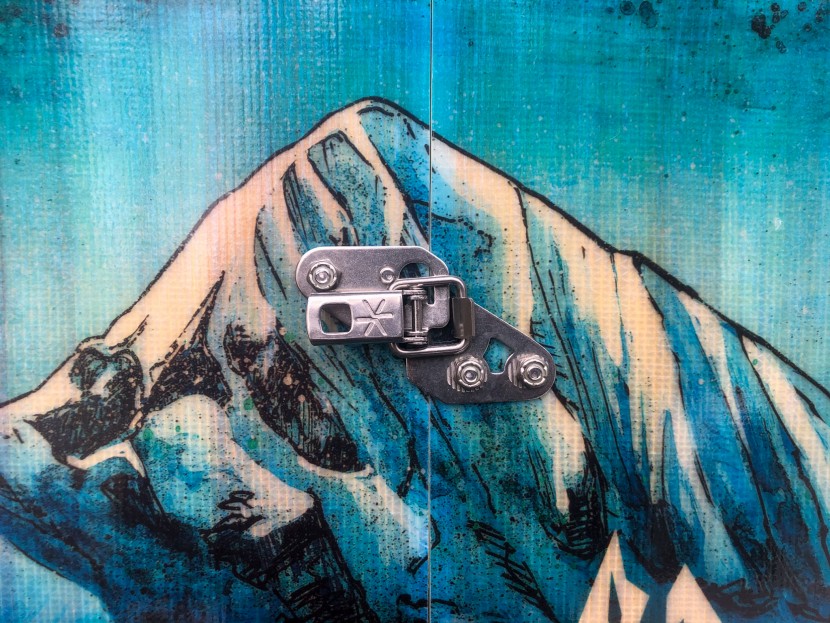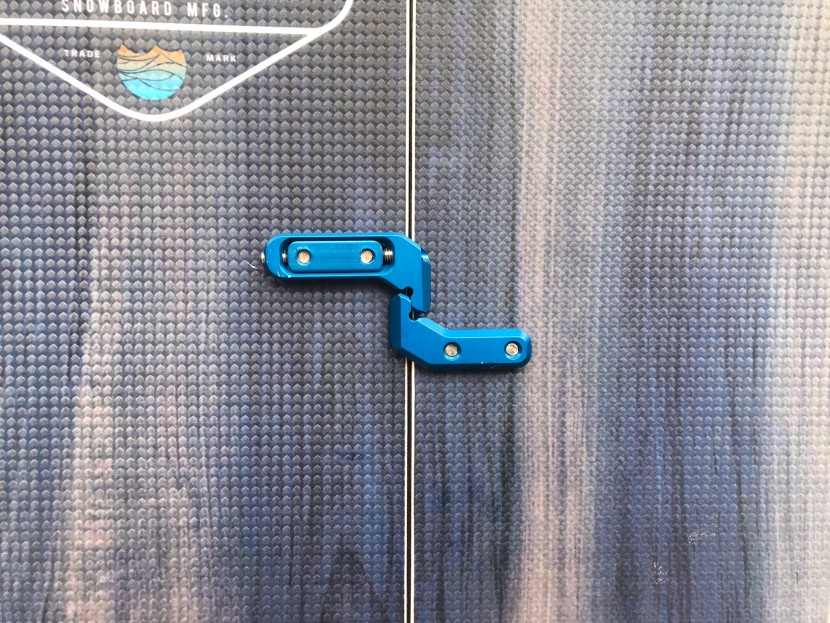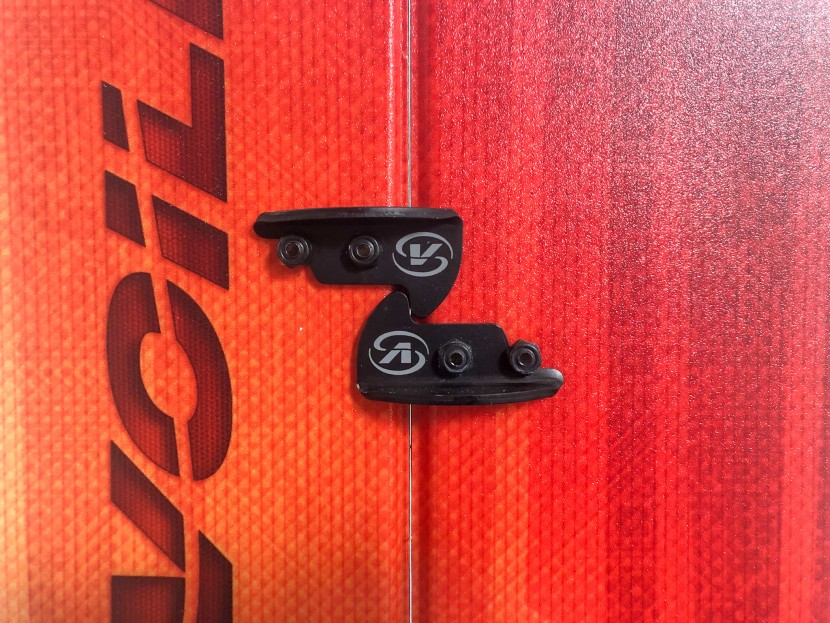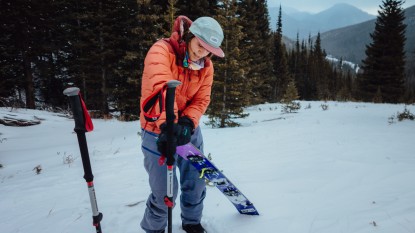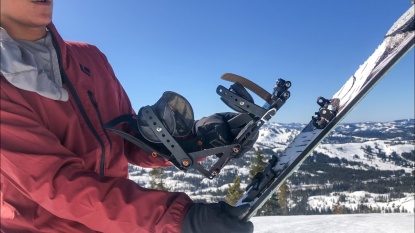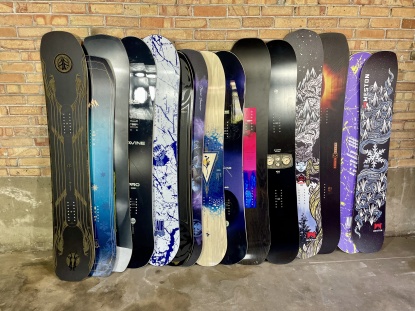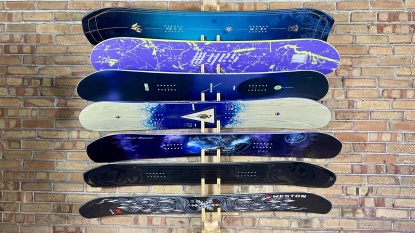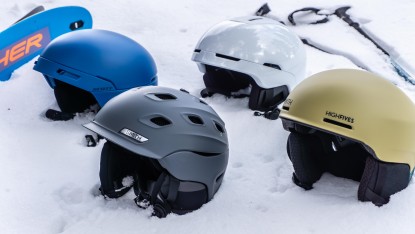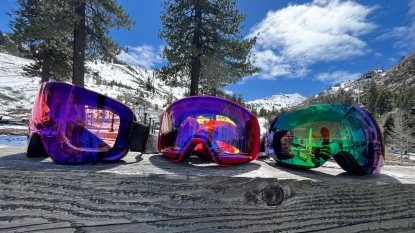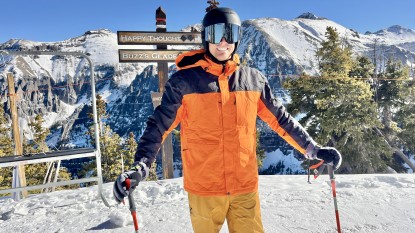In 1992, the first prototype splitboard was made; this tool was invented out of necessity. Snowshoeing has been tried, it works on shorter days, but it is hard. In powder, your weight is concentrated to a very small surface area, which results in deep postholes. Contrast that with split skis where your weight is dispersed across a larger area, which results in less snow depression and no post-holing. The benefit of split skis is the efficiency of movement and is an exponentially, more pleasant uphill experience.
Do I Need to Buy One
If you snowboard and want to explore the backcountry, you should definitely look into buying a splitboard. To quote a splitboard propaganda bumper sticker: Splitboarding is the Answer. It's is the best tool for traveling across and up snow-covered terrain and then shredding back down.
It isn't mandatory; the option of snowshoeing exists but isn't conducive to long term backcountry goals. However, snowshoes do have a valuable purpose. If you're unsure if backcountry snowboarding is for you, then do your first season on snowshoes. Even better, borrow a pair for your first few tours. You'll be in great physical shape and ecstatic when you use a splitboard.
Related: Best Avalanche Beacons
Choices/Types
Splitboards have a lot of jobs to accomplish. The need to climb, ride powder and firm snow and ultimately be so what lightweight. Most splitboards are designed with descending as the first design priority, and most snowboard manufacturers make their splitboards from solid models. Others have differentiated solid and split offerings. In broad strokes, we have two main types of splitboards available to us, which include an all-mountain or powder specific.
All Mountian
This category makes up the vast majority of splitboards on the market. An all-mountain splitboard can stand alone as a quiver of one. It's meant to perform well in powder, on firm snow, and to climb well. These boards can be playful or stiff and fast. Because we can encounter every snow type from blower powder to wind-scoured slopes, we recommend boards that can do it all.
Certain boards may look powder specific, like the Prior Slasher Split, but it offers an impressively versatile all-mountain ride.
Powder Specific
Powder-specific splitboards are considered a niche category as they have a specified use, and there are fewer product offerings on the market. A dedicated powder board might be the best call if you are spending a season shredding Japan's backcountry or you plan on having a quiver. A powder specific board is not the best selection if your home area has a variety of snow conditions and frequent high-pressure systems.
A powder specific splitboard can be identified by an abnormally long length or a shorter length and larger waist width relative to what you normally ride. Often times, these have a pretty deep swallowtail. The added length can have two main pitfalls. First, it can make climbing challenging because of the weight and maneuverability of the board. Second, it makes the descents harder to control in variable conditions. These boards have a place in a quiver. If you're looking for a one board quiver, then an all-around splitboard will be best for you.
Design Considerations
Every board has specific design features to obtain a top-level performance in a variety of metrics. The considerations are broken down into categories that include concepts to consider and which ones may benefit you the most.
Camber Profile
Just like snowboards, splitboards come in camber, rocker, or hybrid profiles. Each has specific benefits to ceratin riding characteristics. The pros and cons of each profile, as they relate to splitboarding, are described below.
Camber
- Pros: Stability when climbing or side-hilling, stability at speeds, stable through chop, superior edge hold, good pop, and powerful
- Cons: Poor floatation in powder on the up and down, generally less playful then rocker
Rocker
- Pros: Good floatation on up and down, playful, easy to transition edge to edge
- Cons: Poor stability/ security on the up track, especially when side-hilling, soft for harder riding, poor edge hold on firm snow
Hybrid
As you would imagine, hybrids aim to blend the benefits of each profile and manage the trade-off of each other to provide a well-rounded board. Not all hybrids are created equal, and the placement of each profile dictates the benefits exhibited. A board with rocker in the middle and camber in the tip and tail is less stable on the skin track when climbing or side-hilling but maximizes playfulness.
In contrast, a board with camber in the middle and rocker on the tip and tail gains the stability benefits of camber while exhibiting better flotation and edge transitions from the rocker. However, this board is likely to be less playful.
Topsheet
The top sheet is responsible for a lot of the weight and stiffness of a snowboard; there are many top sheet options out there. The broad categories are carbon or fiberglass.
Fiberglass is the standard. It is more affordable but heavy and less stiff than carbon.
Carbon is often found on premium or custom splitboards and provides more stiffness, torsional rigidity, and dampness at a lighter weight than its fiberglass counterpart. A carbon board is substantially more expensive but can save around one pound in a splitboard; these boards are often too stiff for the average rider and the terrain we ride most often. If you're looking to make long approaches to a steep line you're planning to charge, carbon could be for you. If not, you should find plenty of stability in a regular fiberglass board that might be a little heavier.
Sidewalls
The backcountry isn't always smooth, soft snow, and sometimes we have to get through the junk to get to the goods.
Sidewalls are another component that can add dampening properties to a snowboard and are typically either ABS or polyurethane. Both are fossil fuel-based plastics, so the recycled option of either is a more environmentally-friendly choice. From a performance standpoint, polyurethane provides more dampening potential than ABS sidewalls.
Connection System
When we are finished ascending, we need to be able to connect our two board halves together. The tighter the connection, the better downhill performance our board should exhibit. The most common attachment systems found on today's splitboards are manufactured by Karakoram, Phantom, and Voile.
Karakoram has an active system that holds the boards together through captured tension, and they offer standard clips and Ultra clips. While both offer strong and active connections, the Ultraclip is easier to handle, more durable, and can be installed without drilling through the board. Don't worry the factory takes care of the drilling.
Phantom uses a passive system that has an adjustable and tight tolerance that provides an impressively secure connection.
Voile has an entirely passive system that is a calculated and nonadjustable connection that relies on a tight tolerance. It provides a good connection.
How to Select What's Best for You
Terrain
Boards are designed to excel in specific terrain and conditions. The terrain is something thing to consider when looking for a new board. A great way to start is to look at what type of riding you wish to do now and next year. Think about selecting a board that can handle some of your more demanding and realistic objectives. At the same time, be realistic about these goals. If you want to have one board that you can yo yo fun backcountry powder laps and then ski potentially icy couloirs with, then you want an all-around splitboard. One that has camber underfoot and edge disruption to provide additional traction. An example of this is the Jones Solution.
If you want one board to thrive in powder and provide a fun ride on your favorite corn zone, a directional board that has camber underfoot and more rocker in the tip might fit your needs; one example is the Venture Storm.
Understanding your objectives and style is key to selecting a one board quiver that can do everything you want to do. After that has been outlined, you can look at our reviews to see which one fits the mold best.
Style
We have looked at the terrain and the conditions. We also want to consider what your riding style is. Most reputable snowboard manufacturers are producing a quality product. That product is designed with a particular style of riding in mind. Matching the board to our preferred style of riding is like finding that perfect cinderella slipper.
If you like to smear your turns for easy speed control, something playful like the Voile Spartan Ascent is a great choice.
If you like to ride big lines with fast, long radius turns, the Jones Solution is a stable and versatile model.
If your a soul surfer, the long nose and fluid flex of the United Shapes Covert will allow you to surf the earth and unlock your inner John John Florence.
Size
Basing your splitboard size on your resort snowboard is an appropriate starting point. An exception to this would be if your resort ride is a park board. In this case, you will likely want to add a couple of centimeters to your prospective splitboard. Additionally, remember that in the backcountry, you will be carrying 10-20 lbs of extra weight. You have a shovel, beacon, probe, right? Water and whatever other essentials you bring with you will increase your weight and thus warrant a larger board that will float all of this in the backcountry.
There is no definitive answer on how much to size up (if at all); this depends on the type of resort board and the type of splitboard. For the sake of argument, let's say you ride a 161cm Jones Flagship solid snowboard in bounds (the solid Flagship is essentially the same as the splitboard Solution). If your primary backcountry terrain mirrors your resort terrain, the 161 Jones Solution will likely be fine, but you could also jump up to the next size (164 in this case). The 164 Solution would provide more float but be a little heavier and less nimble than the 161. If you've never had issues sinking the nose on the 161, then you would likely be content on the 161 Jones Solution in the backcountry.
Suit to Your Objective
Most people are looking for one splitboard that can do it all. Before getting bogged down in design considerations, take a look at your usage ideas and frequencies. If you understand this, then you can match the design considerations to suit your objective. Our best in class and individual reviews will highlight the applications and characters of each model to help you choose the best board for your next adventure.


